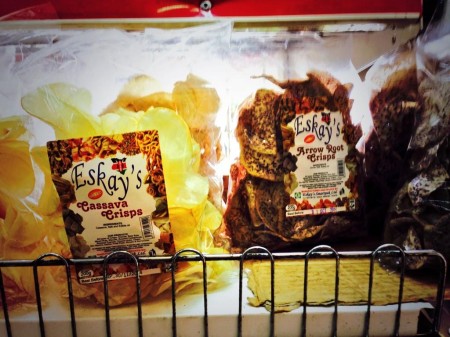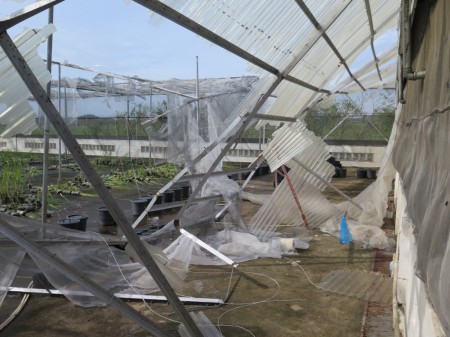- Genetic structure of the Greek olive germplasm revealed by RAPD, ISSR and SSR markers. Reflects usage.
- Genotyping of Vitis vinifera L. within the Slovak national collection of genetic resources. Unclear whether it reflects usage.
- Molecular confirmation of species status for the allopolyploid cotton species, Gossypium ekmanianum Wittmack. It has been hiding in collections as “wild” G. hirsutum, but it really isn’t.
- North American animal breeding and production: meeting the needs of a changing landscape. We’ll need a better fit of genotype to production environment, better meat quality, better animal health and decreased residual feed intake; climate change will make it more difficult, but it will still be possible, especially using new genomic tools.
- Urban agriculture: a global analysis of the space constraint to meet urban vegetable demand. We’re going to need bigger cities, to grow enough vegetables in them, to feed them. No, wait…
- Niche Markets for Agrobiodiversity Conservation: Preference and Scale Heterogeneity Effects on Nepalese Consumers’ WTP for Finger Millet Products. That’s Willingness to Pay. And there is a bit of the population with enough of it to suggest that a price premium could translate into more acreage. And maybe more public investment.
- Selection and Crossbreeding in Relation to Plumage Color Inheritance in Three Chinese Egg Type Duck Breeds (Anas platyrhynchos). Hybrids are better layers, but then you can lose the desired plumage. Here’s how to have your beautiful duck and eat it too.
- Micronutrient Density and Stability in West African Pearl Millet — Potential for Biofortification. There is some, but there would be more if some Indian material was used in breeding too.
- Genetic diversity in kiwifruit polyploid complexes: insights into cultivar evaluation, conservation, and utilization. Interploid crosses can increase genetic diversity. The red-fleshed cultivars are genetically distinct. Red? Really?
- Natural hybridization, introgression breeding, and cultivar improvement in the genus Actinidia. We should collect new material in natural hybrid zones.
Bambara groundnut goes online
A workshop on Bambara groundnut (Vigna subterranea L) was co-hosted by the Crop Research Institute of Ghana and the Crops for the Future Research Centre (CFFRC) last September in Accra. One of the recommendations was to re-establish an on-line forum for the crop. We’ve now heard from Sean Mayes of CFFRC that “(t)he first phase of this is now complete.”
The current material on the site is really illustrative and we would welcome contributions from far and wide. Please make sure that you own the copyright on anything you would like posted, but we would welcome anything from papers to Bambara groundnut researcher profiles, news, current research etc.
The aim of the site is to link together people working in similar areas so that the individual efforts on Bambara research can begin to add up to something greater. This will benefit everyone involved and help to provide hard scientific evidence of how Bambara can realistically contribute to food security and income generation. Integrating research from genomics through to socio-economic policy is a key aim for underutilised species which often suffer from a range of problems across the entire value chain, so we would welcome input and contribution from all disciplines.
The list of contacts we have is currently limited to those who have contacted us, so please feel free to forward the site address to colleagues and other you feel would be interested. If you would prefer to be removed from the list, please let Razlin know (Razlin (dot) Azman (at) cffresearch.org). If you could also send any contributions/questions/concerns to Razlin as she will be the main person responsible for updating and maintaining the site on a day-to-day basis.
Simply as a starting point, a number of international researchers have offered to act as a steering committee for the site to get things off the ground. However, we are hosting the site on behalf of the Bambara groundnut community, so would also welcome suggestions and offers to help develop the site as a focal point for Bambara groundnut research.
Feel free to use the comments here also to leave suggestions. We’ll make sure they reach their destination.
Incidentally, speaking of neglected crops, can’t resist posting this photo I took yesterday in a Nairobi supermarket.

Featured: Glenda
Mike Jackson adds some detail to our short note on the recent typhoon in the Philippines:
This typhoon, known as Glenda in the Philippines, actually did more damage at IRRI probably than any other in recent years. In fact, one of my former staff who has been at IRRI for 40 years or so, told me it was the worst damage she had experienced. But, resilient as ever, IRRI staff have cleared up much of the damage, roofs and windows will be replaced, and soon things will get back to normal.
Global rice genebank just fine
Just a quick note to say that Typhoon Rammasun caused some damage at IRRI, but apparently nothing major. The genebank is ok, but the screenhouse used to keep some wild rice plants will clearly have to be repaired. I’m assured that’s going to be a high priority.

Correction to our post on BCS
Lastus Kuniata, Head of Research and Development at Ramu Agri Industries Ltd in Papua New Guinea, quite rightly corrected our piece on Bogia Coconut Syndrome, both here and on Pestnet:
“The same phytoplasma is suspected to affect other palm crops, such as oil palm and betel nut” this statement by Luigi to suspect BCS in oil palm is not true. This should read “sago palms and confirmed in betelnuts”.
Sorry about that.